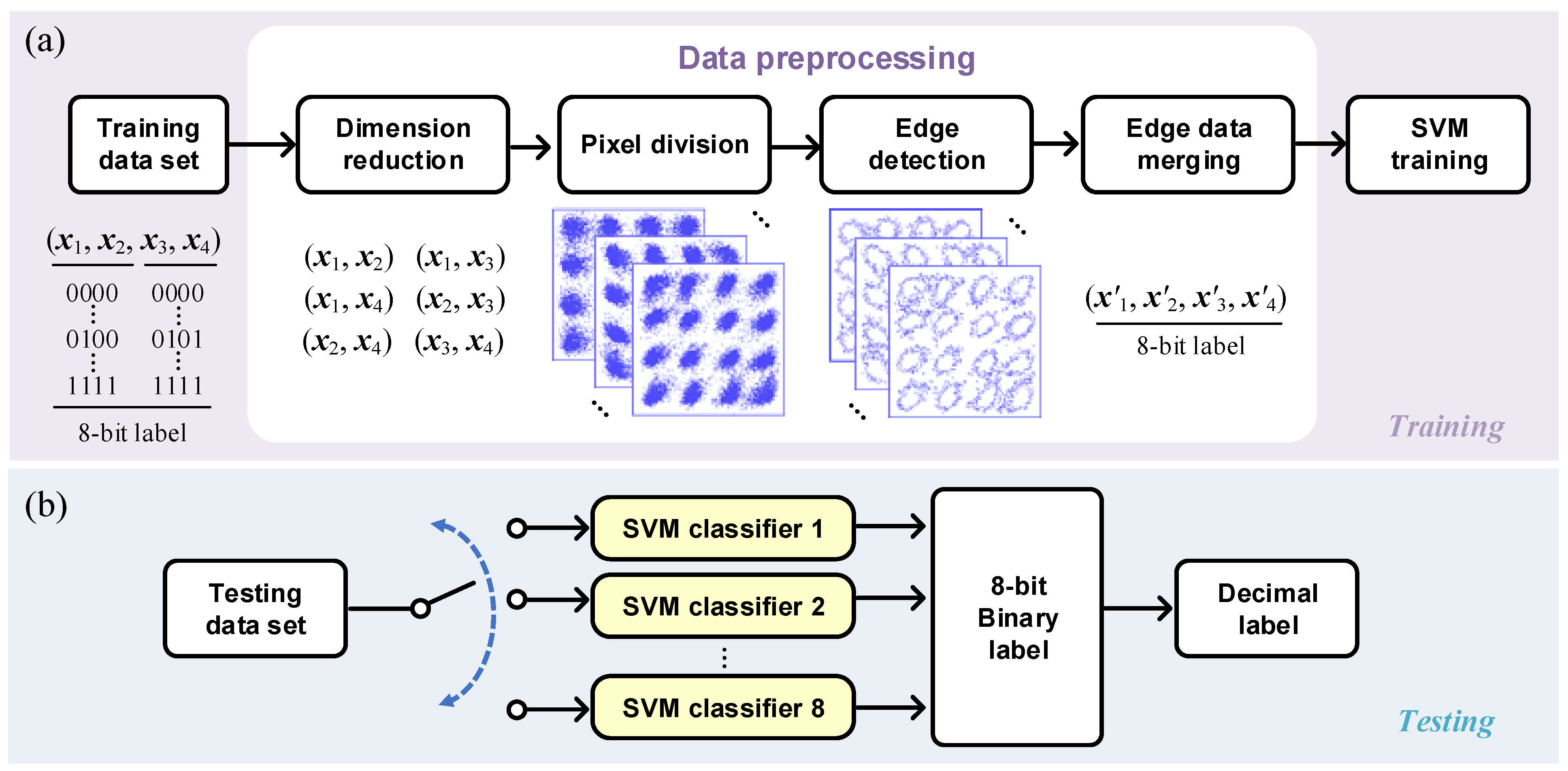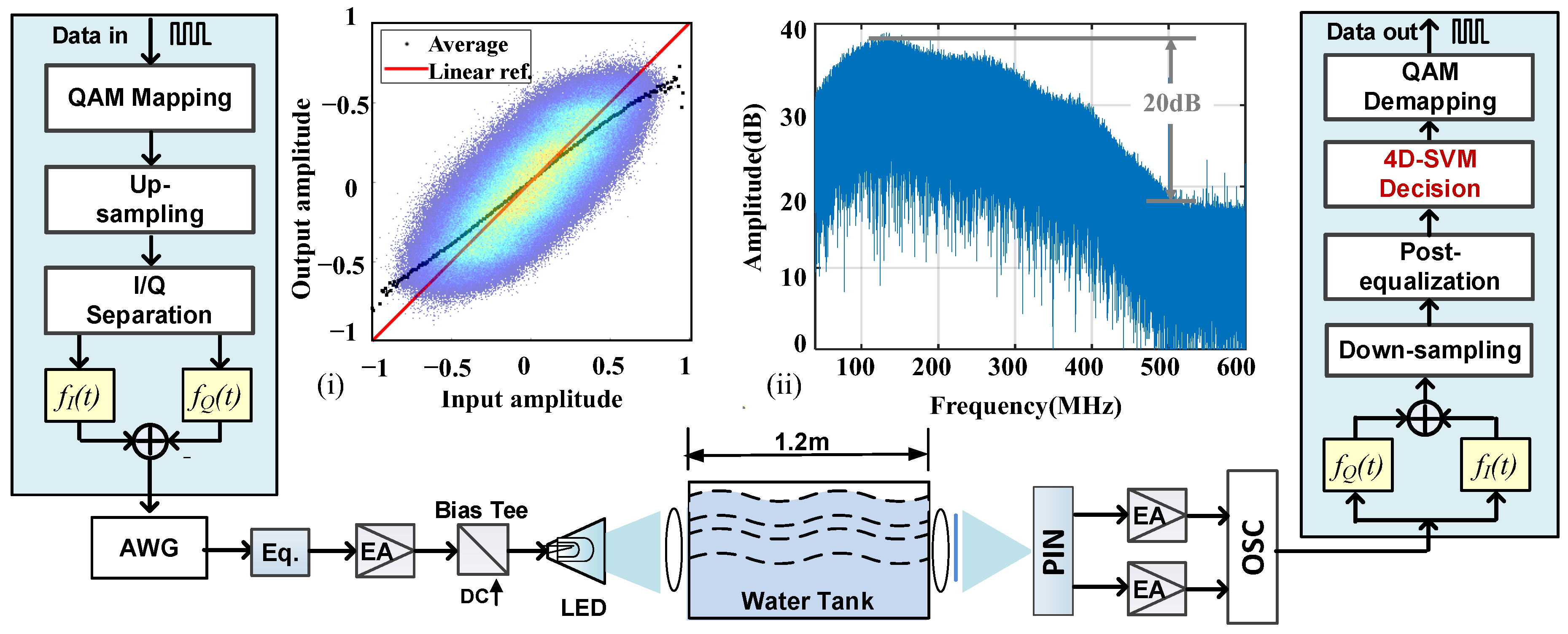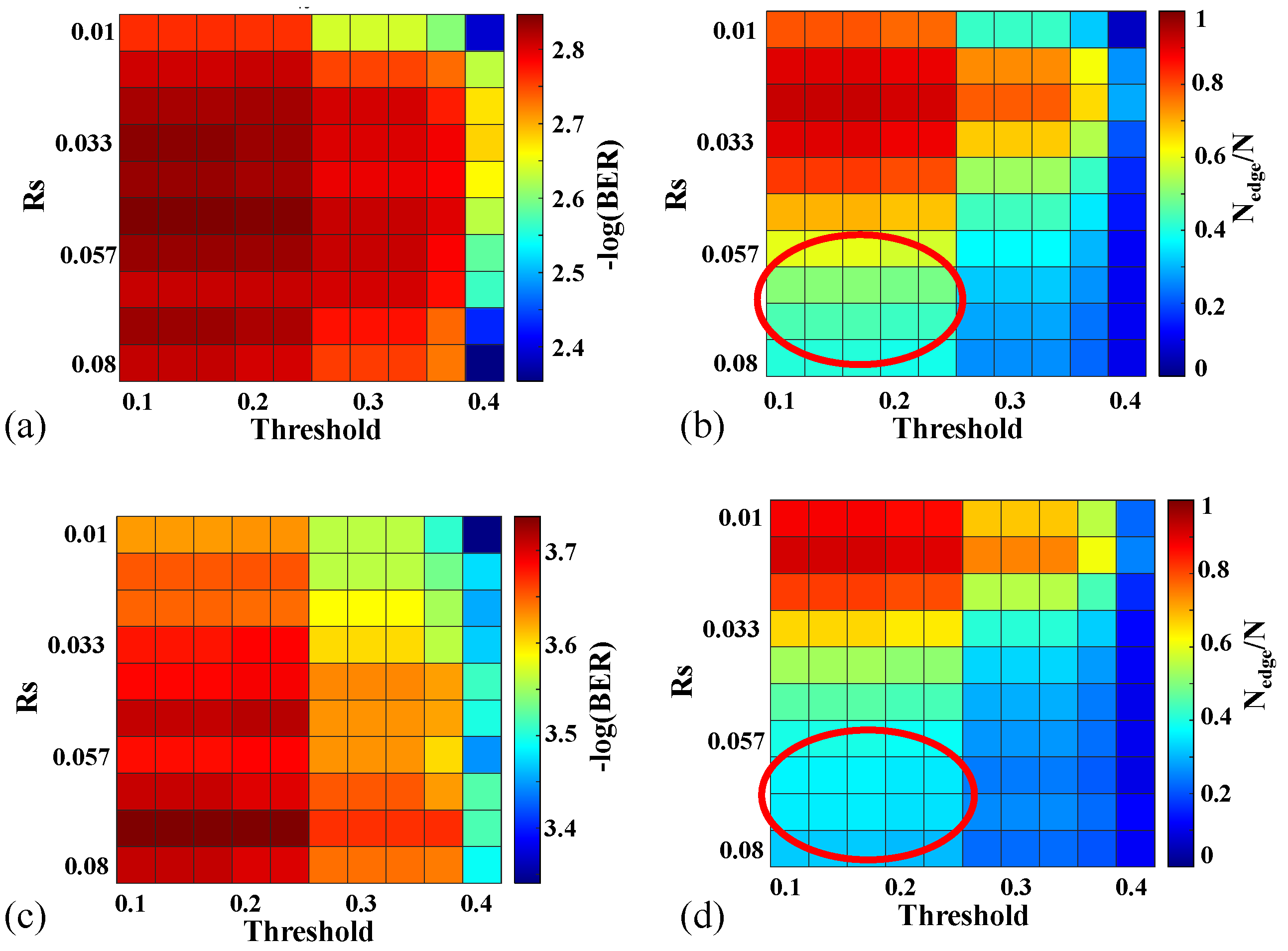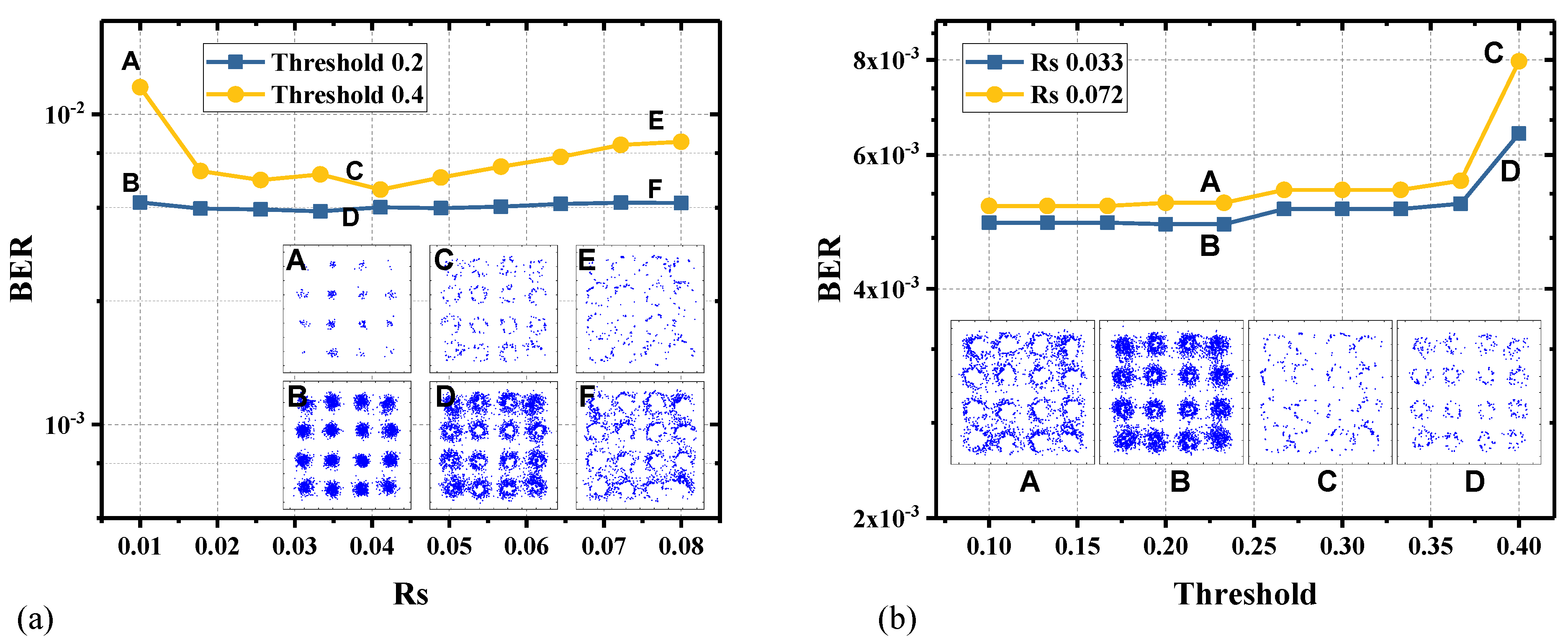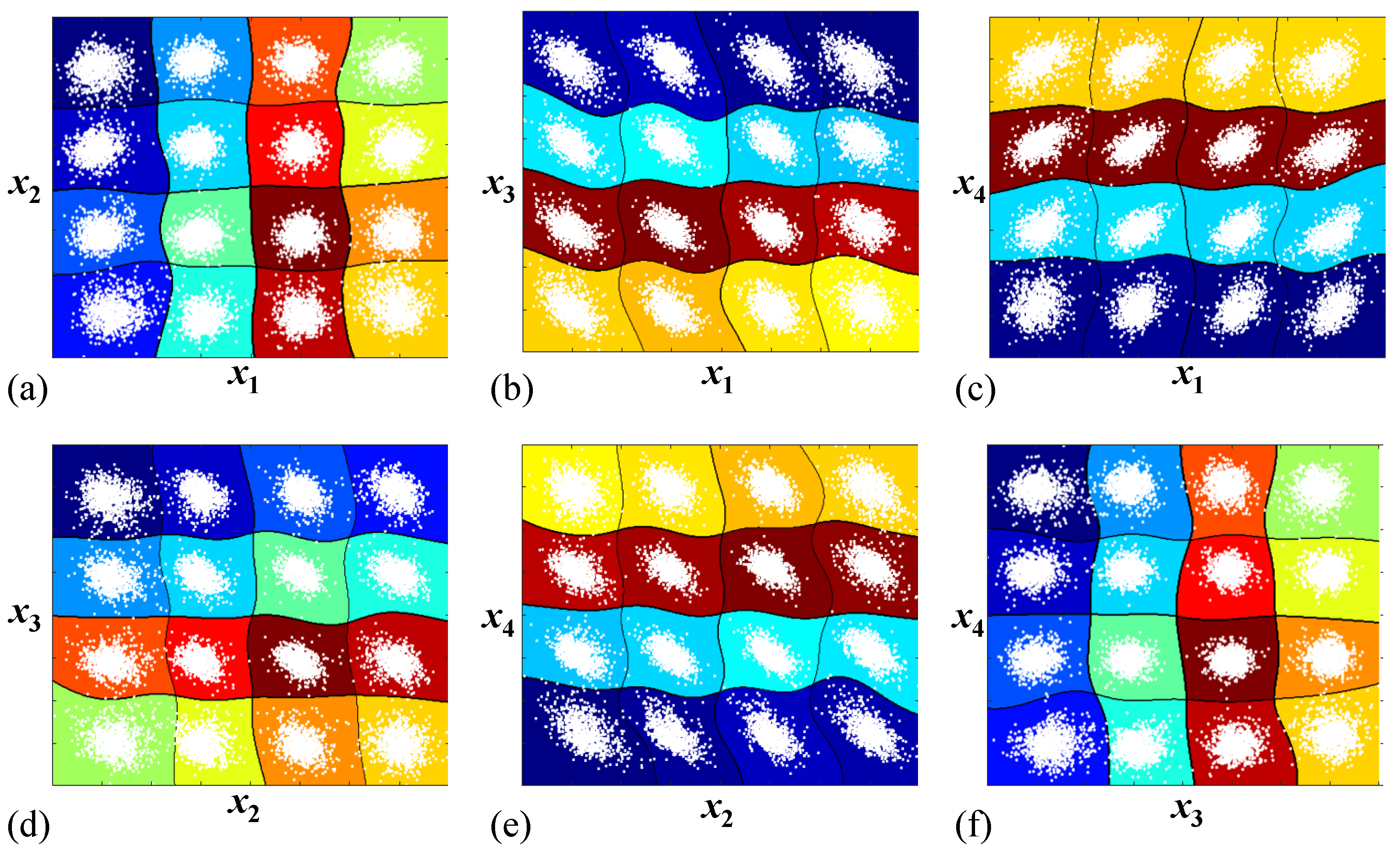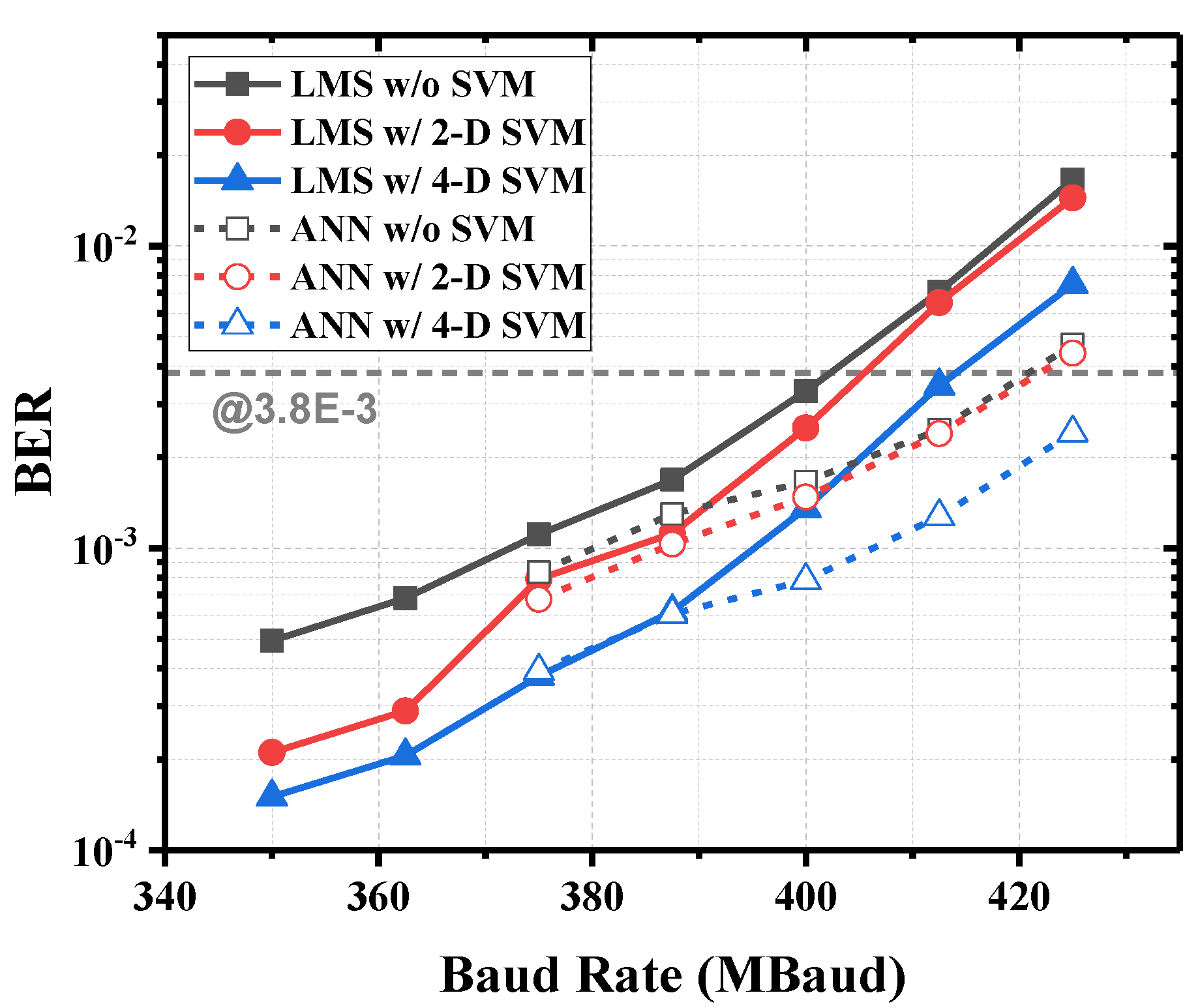1. Introduction
With the development of ocean exploration, the demand for high-speed underwater wireless data transmission is increasing. Since radio frequency is not suitable for underwater communication because of the great power attenuation [
1], acoustic communication is widely used, but due to the low transmission speed and large latency, the typical data rate of acoustic communication is extremely limited. Due to the low attenuation window [
2,
3] at blue-green spectrum, underwater visible light communication (UVLC) is supposed to provide long-distance and high-speed transmission, and abundant investigations on light-emitting diodes (LEDs) have been reported [
1,
4,
5,
6,
7].
However, inter-symbol interference (ISI) and nonlinear impairment are the two main problems that restrict the performance of UVLC system. On the one hand, the UVLC system is bandwidth-limited due to the low modulation bandwidth of LED [
5], and the low-pass filtering effect will induce severe ISI. On the other hand, the UVLC channel is faced with absorption, scattering, and turbulence [
8]. Therefore, large driving power is required to ensure the desired signal-to-noise ratio (SNR) at the receiver. The nonlinearity from optoelectronic devices such as LEDs, photodiodes, and electrical amplifiers (EAs) [
6,
7] becomes severe at high amplitude.
In order to eliminate the combination of ISI and nonlinear impairment, digital signal processing (DSP) is required. Generally, DSP includes equalization and decoding. Constant modulo algorithm (CMA), least mean square (LMS)-based linear equalizers, and Volterra series or polynomial-based nonlinear equalizers [
9,
10,
11] have been widely investigated. As to decoding, hard decision based on Euclidean distance is most commonly used, whereas soft decision is supposed to provide better performance. In this context, the latest researches have employed machine learning algorithms such as support vector machine (SVM) [
12,
13,
14,
15] and K-means [
16,
17] for soft decision. SVM-based soft decision is especially effective for quadrature amplitude modulation (QAM) when there is strong nonlinearity [
14,
15], because the decision boundary can be adjusted according to the distribution characteristics of constellation points. However, previous works mainly concentrate on 2-dimensional (2-D) separate symbol [
12,
13,
14,
15], whereas the correlation between consecutive symbols is ignored. Inspired by [
18,
19], the constellation can be expanded to a higher dimensional constellation by concatenating consecutive symbols. For QAM signal, the original 2-D constellation is expanded to a 4-D constellation. The nonlinear effect and ISI interact with each other. It is difficult to remove the correlation between adjacent symbols thoroughly with a feedforward equalizer, and the high-dimensional clusters will be distorted due to the combination of residual ISI and nonlinear impairment.
In this paper, we propose to employ SVM to find the optimal decision hyperplane for the consecutive-symbol-expanded 4-D constellation in an experimental UVLC system. The proposed scheme is used for soft decision, independent of the post-equalization process. As the intensity modulation-direct detection (IM-DD) system requires a real and positive signal, a pair of carrierless amplitude and phase (CAP) shaping filters are used for CAP modulation [
20,
21] so that the complex-valued QAM signal can be converted into a real-valued signal. Different from existing works that employ SVM for 2-D normal constellation [
12,
13,
14,
15], the correlation between consecutive symbols is considered in this work. However, for the consecutive-symbol-expanded 4-D constellation, the computational complexity of SVM training phase becomes higher because of the demand for more classifiers and larger training data size. To deal with the high computational complexity resulting from the demand for more classifiers, the bit-based binary SVM is applied as the multi-class SVM strategy, so that the number of required classifiers can remain small [
15]. Additionally, since a SVM model only depends on a few support vectors [
12], which are the nearest to the hyperplane, it can be more efficient if the edge points are picked out in advance because the support vectors are included in the edge points. To deal with the high computational complexity resulting from the demand for larger training data size, a simple data pre-processing method is used during the SVM training phase to detect the edge points of each cluster and abandon the redundant training data. Experimental results prove the feasibility of the proposed method. When LMS-based linear equalizer is used for post-equalization, the available baud rate is increased to 412.5 MBaud with the proposed method under the 7% forward error correction (FEC) threshold.
3. Experimental Setup
Figure 3 shows the experimental setup for the underwater visible light communication system. The original binary data are generated from an offline MATLAB program. First, the binary data are mapped into 16-QAM symbols. After a 4-time up-sampling, the in-phase and quadrature parts of the complex-valued QAM symbols are separated. Then, a pair of orthogonal shaping filters (roll-off factor = 0.205) are used for CAP modulation. Afterward, the real-valued signal is loaded into an arbitrary waveform generator (Tektronix AWG710B, 4.2GSa/s). As the typical −3 dB modulation bandwidth of large-scale LED is limited to a dozen of MHz or lower, a hardware pre-equalization circuit is used to increase the power of high-frequency component and decrease the power of low-frequency component [
20]. The hardware pre-equalization circuit is a single constant-resistance symmetrical bridged-T amplitude equalizer [
20] with the resonant frequency at 500 MHz and low-frequency attenuation 28dB. Afterward, the signal is sent to an amplifier (ZHL-2-8-S+), followed by a Bias Tee (ZFBT-4R2GW-FT+) which couples the signal and direct current to drive a blue LED (−3 dB bandwidth is 17 MHz) [
7]. After transmission through a 1.2 m water tank, the signal is focused by a lens (Ø75 mm, f = 60 mm) and detected by a PIN (Hamamatsu, S10784). Tap water is used in this experiment. The system is line-of-sight point-to-point transmission and turbulence can be ignored, so that the UVLC channel is approximately deterministic. The PIN outputs two opposite signals which are subtracted after the amplifier, oscilloscope (DSO9404A, 20GSa/s) and synchronization to suppress the common mode noise of the system.
Then, the received signal is sent into the offline digital signal processing (DSP) block for data recovery. First, two matched filters are employed for CAP demodulation. Since the zero-forcing (ZF) pre-equalization to obtain a flat spectrum is not suitable in UVLC system [
25], the hardware pre-equalization circuit merely provides the rough power allocation and a more balanced SNR distribution. After down-sampling, LMS-based linear adaptive post-equalization is used to mitigate the ISI. The tap-number of the LMS-based linear equalizer is 21, and the step-size is optimized at every operating condition in this experiment. Next, the proposed SVM-based soft decision for 4-D constellation is used to determine the 4-D decision boundary. We use radial basis function (RBF) as the kernel function. The detail implementation about the scheme has been introduced in
Section 2.2. Finally, the original data are recovered after QAM de-mapping.
The inset (i) shows the normalized input amplitude–output amplitude (AM–AM) of the UVLC system at 1.1V and 1.6 Gbps. The red line is the linear reference. The black points are the average value in a small grid of input amplitude. Obviously, the AM–AM curve displays nonlinear effect. The inset (ii) is the spectrum of the received signal which is obtained by fast Fourier transform (FFT). The baud rate of the signal is 400 MBaud. Although hardware pre-equalization circuit is applied, the high frequency component still displays great attenuation. In summary, the system is working at nonlinear and bandwidth-limited condition. It is difficult to remove the correlation between adjacent symbols thoroughly. Independent of the equalization method, the proposed method is used for soft decision, which enhances the decoder.
4. Results and Discussion
This section introduces the experimental results and discussion. First, the performance of SVM-based soft decision for normal 2-D constellation and consecutive-symbol-expanded 4-D constellation at different training data size is given in
Figure 4. It should be noted that the system is working at 1.1 V and 1.6 Gbps, and data preprocessing is not employed. As
Figure 4a shows, the convergence speed for normal constellation with SVM is faster because the number of classes is smaller, whereas, if there are enough training data, 4-D constellation with SVM can provide better bit error rate (BER) performance. However, as
Figure 4b shows, the percentage of support vector (SV) in the training data is decreasing when there is more training data. It indicates that there are considerable redundant training data. The complexity of the training phase scales between O(dNt2) and O(dNt3) for SVM with d-dimensional feature vectors and Nt training points. Therefore, data preprocessing is necessary for reducing computational complexity. To make a trade-off between BER performance and SVM training complexity, the training data size is set as 26,214. The trained SVM models can be applied for a period of time, because the system is approximately deterministic at a fixed operating condition. In a practical system, the training process can be operated offline for some typical operating conditions.
To search for the optimal parameters for the data preprocessing method, we measure the BER performance and the compression ratio (
) with different pixel size Rs and Threshold of the Sobel operator. First, the experimental results are measured at a data rate of 1.6 Gbps and V
pp of 1.1 V, as shown in
Figure 5a,b.
Figure 5a shows the BER performance under different parameter conditions. The area with larger value indicates a better BER performance. However, not all the Threshold and Rs pairs with large-log (BER) are appropriate to simplify the training data set in the edge detection process.
Figure 5b shows the compression ratio of the training data after pre-processing. The area with a lower value indicates that the Sobel edge detector worked and the training set becomes simplified, to a certain extent. To make a tradeoff between the BER performance and compression ratio, we prefer the parameters that correspond to lower BER and lower
. As a result, at the data rate of 1.6 Gbps, the optimal Threshold ranges from 0.1 to 0.23, while the optimal Rs ranges from 0.057 to 0.08. To ensure the generalization of the optimal parameters, the BER performance is also measured at the operating condition of 1.1 V, 1.4 Gbps. The results are shown in
Figure 5c,d. Similarly, at the data rate of 1.4 Gbps, the optimal threshold ranges from 0.1 to 0.23, meanwhile the optimal Rs ranges from 0.057 to 0.08. The optimal ranges are coincident with that at the data rate of 1.6 Gbps.
More specifically, as
Figure 6a shows, we illustrate the BER performance versus Rs in the case of two fixed Threshold values under the condition of a data rate of 1.6 Gbps and V
pp of 1.1 V. When Threshold equals 0.2, the BER keeps a low value. The constellation diagrams after edge detecting under certain values of Rs are inserted as subfigures. We can observe that the constellation F obtains a clear profile, which effectively reduces the training data size. By contrast, constellation B shows that the edge detection algorithm has not obtained a good result and that there are many redundant data even though BER performance is barely satisfactory. Similarly, as
Figure 6b shows, we also illustrate the BER performance versus Threshold in the case of two fixed Rs values. We can observe that the constellation A is well edge detected, while the constellation B has a lot of redundant data. It can be seen from the aforementioned experimental results that the edge detection algorithm can achieve comparatively optimal performance when the threshold is 0.072 and Rs is 0.2, the parameters adopted in rear experiments.
Next, we investigate the BER versus box constraint, which is a key parameter of SVM, corresponding to
C in Equation (2). The BER performance is measured by changing box constraint from 0.1 to 100 at 1.4 Gbps and 1.6 Gbps. As shown in
Figure 7, when the box constraint increases, the BER firstly decreases. When the box constraint reaches around 1, the BER drops to a minimum value, and the BER gradually increases as the box constraint increases. The constellation diagrams at 1.4 Gbps and 1.6 Gbps are inserted as inset (i) and inset (ii), respectively. The trend of the BER curve at 1.4 Gbps is slowly varying because the ISI is not severe at a low data rate, and the boundary of constellation clusters is clear. However, when the data rate exceeds 1.6 Gbps, the constellation is distorted more severely. BER increases significantly as box constraint becomes larger, indicating that it is more at risk of overfitting. When the box constraint is 1, the SVM-based soft decision performs well at the two data rates. We can infer that constellation with less distortion has higher tolerance for the variation of box constraint. The parameter can be obtained at the condition with a high data rate and applied to other operation condition with lower data rate.
Figure 8 shows the projection of 4-D constellation points on a 2-D plane. The decision boundary obtained by SVM is also illustrated. Since the four axes are combined in pairs, six different projection planes can be illustrated (
Figure 8a–f). As can be seen from
Figure 8a,f, the constellation points spread out into a nearly circular shape because the axes of the projection plane are from the same time while the constellation clusters in
Figure 8b–e spread out into an oval shape because the axes are from different time. The correlation between the two consecutive symbols will crosstalk each other and lead to the special ellipse constellation. Additionally, the outer constellation points spread more than the inner circle, which indicates the nonlinear effect in the UVLC system. The SVM-based decision boundary for elliptical constellation clusters is adjusted adaptively according to the distribution characteristics of constellation points. Therefore, the proposed method can deal with the distortion resulting from residual nonlinearity and ISI after post-equalization. The adaptive decision boundary is supposed to outperform the simple hard decision.
Figure 9 shows the BER performance on different baud rare under conditions without SVM, normal 2-D constellation with SVM (abbreviated as 2-D SVM in
Figure 9), and 4-D constellation with SVM (abbreviated as 4-D SVM in
Figure 9) after post-equalization. It should be noted that the SVM-based soft decision is applied in the decoding process, independent of the post-equalization. The solid lines are results employing LMS-based linear equalization. Obviously, 4-D constellation with SVM performs best, followed by normal 2-D constellation with SVM and without SVM. When the baud rate is low, the nonlinear effect is the dominant impairment, normal 2-D constellation with SVM can provide a significant performance gain. However, as the baud rate increases, ISI becomes the dominant impairment, 4-D constellation with SVM displays a larger performance gain. At the operating condition of 412.5 MBaud, the BER of LMS without SVM and LMS with 2-D SVM has exceeded the 7% FEC threshold (3.8× 10³), while the BER of LMS with 4-D SVM still satisfies the threshold. The available baud rate is increased by 12.5 MBaud, corresponding to the data rate improvement of 50 Mbps.
For fair comparison, we also add the results employing artificial neural network (ANN) for nonlinear equalization as the dashed lines in
Figure 9. The ANN is a feedforward complex-valued network with a dual branch structure [
6]. The input layer has 21 nodes, sharing the linear and nonlinear branches. The nonlinear branch contains one hidden layer with 10 nodes. The activation function is complex-ReLU. The Adam optimizer is used for training. We can observe that the ANN-based nonlinear equalization performs better than the LMS-based linear equalization. With the joint effort of 4-D SVM soft decision, the BER can keep under the threshold at 425 MBaud. It should be noted that the training size is 26,214, whereas after data preprocessing the training size is decreased by 56%. As the complexity of the training phase scales between O(
dNt2) and O(
dNt3) for SVM with
d-dimensional feature vectors and
Nt training points, the required computational resource has been significantly reduced.

